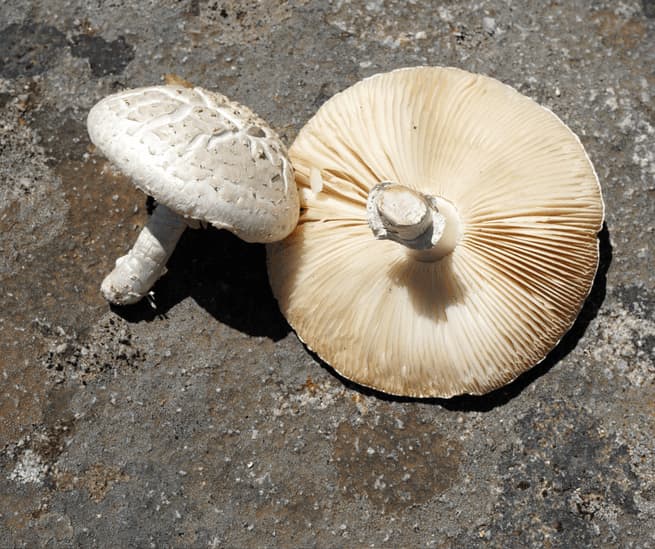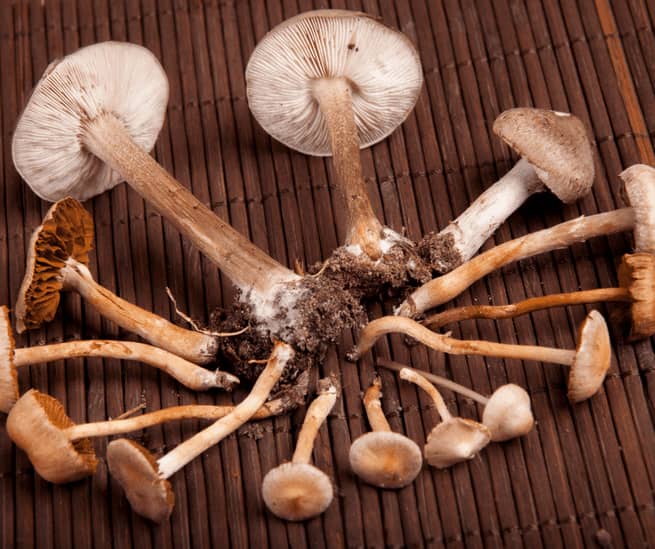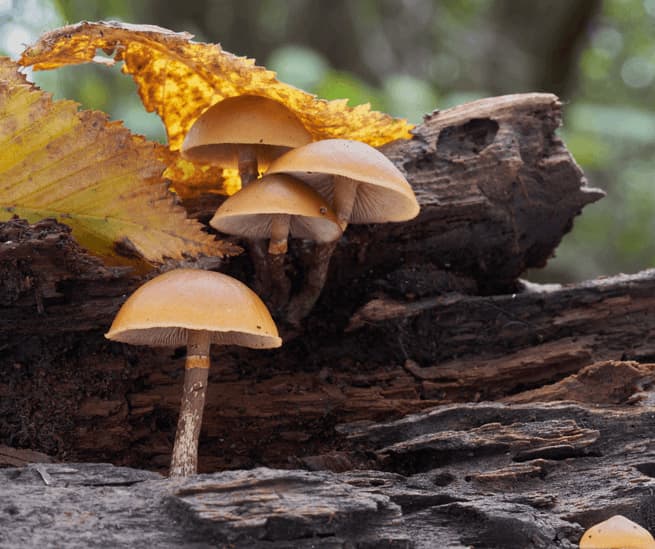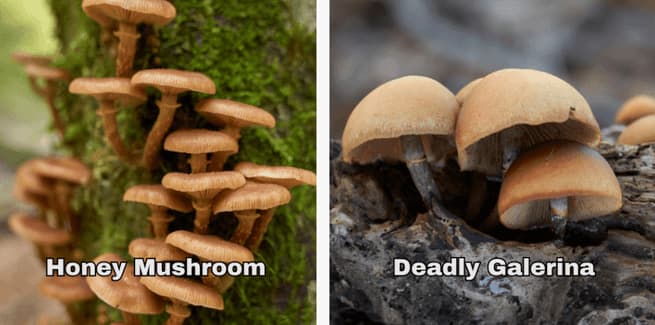

Foraging for wild mushrooms is just as enjoyable as it is rewarding. Every year, thousands of adventurous foragers set out into the forest to search for tasty treats, but the hobby comes with some unfortunate risks. The line between delectable and dangerous mushrooms is incredibly thin, and one rookie mistake could send you to the hospital – or worse.
Fortunately, the odds of fatal mushroom poisoning are relatively low. In the United States, there are only around three mushroom poisoning deaths a year. Furthermore, only 3% of known mushroom species are toxic (1). However, no one wants to risk their life for a freshly foraged meal.
While most mushrooms are generally harmless, you should always forage with caution and be 100% certain in your findings before consuming any wild mushrooms you may encounter during your hunt.
Toxic compounds found in mushrooms

There are several different kinds of toxic compounds that can be found in wild mushrooms. Some of them can cause mildly uncomfortable side effects, while others can pose life-threatening risks to your health.
Amatoxins are a group of toxic compounds primarily found in Amanita, Galerina, and Lepiota genera but also found in Conocybe filaris. The toxin harms the liver and kidney, leading to severe and sometimes fatal damage. It is responsible for 90% of mushroom poisoning deaths (2). Amatoxins typically have a delayed onset of symptoms, including nausea, vomiting, abdominal pain, diarrhea, and jaundice.
Orellanine is a nephrotoxin found in some species of the Cortinarious genus, such as the Deadly Webcap (Cortinarius rubellus). There are around 2,000 to 3,000 species within the Cortinarius genus, making it the largest known fungi genus (3). Since many of these mushrooms are small to medium-sized and share many characteristics with edible mushrooms, they can be challenging to distinguish from non-toxic species. The toxin is highly poisonous and can cause severe or life-threatening symptoms, especially if not treated immediately. However, Orellanine poisoning symptoms have a delayed onset and can appear several days or even weeks following consumption. These symptoms can include abdominal pain, nausea and vomiting, diarrhea, muscle weakness, swelling of legs, intense thirst, jaundice, and decreased or absent urination. In most severe cases, Orellanine poisoning leads to kidney failure.
Muscarine is a toxic alkaloid usually found in the Inocybe and Clitocybe genera. Its concentration can vary from species to species. Although Muscarine is toxic, it is seldom lethal. Nonetheless, it’s best to be avoided at all costs as it can cause a variety of unpleasant symptoms such as sweating, nausea and vomiting, excessive salivation, abdominal pain, diarrhea, slowed heart rate, and, in more severe cases, respiratory distress.
Gyromitrin is commonly found in mushrooms from the Gyromitra genus, such as the False Morel. When ingested, Gyromitrin breaks down into a toxic compound called Hydrazine, which can result in serious damage to the liver, kidneys, and central nervous systems. Depending on how much is consumed, Gyromitrin can cause mild to severe symptoms, though it’s rarely deadly. Symptoms occur within six to twelve after ingestion and can include nausea and vomiting, dizziness, confusion, diarrhea, abdominal pain, headaches, jaundice, and seizures.
Coprine is a mycotoxin found in mushrooms from the Coprinopsis genus, like the Common Inkcap (Coprinopsis atramentaria). Unlike other mycotoxins, coprine is not toxic on its own and is found in many popular edible species. However, it interacts with alcohol and creates a reaction in the body, producing unpleasant and potentially dangerous side effects depending on how much alcohol is consumed. Symptoms of Coprine poisoning include facial flushing, headache, nausea and vomiting, high blood pressure, rapid heart rate, and disorientation. These effects can last for several hours. If you consume a mushroom with Coprine, you should wait at least 24 to 48 hours before drinking alcohol to avoid any adverse symptoms.
Ibotenic acid is found in certain Amanita species, such as the Fly Agaric (Amanita muscaria) and the Panther Cap (Amanita pantherina). When ingested, Ibotenic acid goes through a process called decarboxylation, which converts it into Muscimol, the compound responsible for a hallucinogenic effect. The toxins are only considered dangerous or lethal in high amounts. Symptoms can include nausea and vomiting, anxiety, confusion, lack of coordination, altered consciousness, and hallucinations. Mushrooms containing these toxins have been successfully consumed through proper preparation methods like parboiling and drying; however, it is not recommended to attempt this since these mushrooms require extensive knowledge of preparation methods to ensure there’s no risk of poisoning.
Psilocybin is the psychoactive compound found in magic mushrooms. If you consume mushrooms with this compound, you can experience an altered state of consciousness, hallucinations, nausea and vomiting, anxiety, euphoria, or enhanced sensory perception. Psilocybin can be psychologically intense, but they are not typically harmful to the body, especially in moderate amounts. If you intentionally consume mushrooms with these compounds, you should be cautious and responsible, as improper use can lead to severe psychological distress.
Characteristics of toxic mushrooms

There are certain characteristics that are common in toxic mushrooms that can help you identify them. Still, these traits should be treated as a guideline rather than definitive determinants of toxicity. Mushroom identification is a complex process that requires assessing multiple factors in conjunction with one another. Some of the most common characteristics of toxic mushrooms include:
Unpleasant smell
Many toxic mushrooms have an unpleasant smell, such as a chemical, acrid, or rancid odor, whereas many edible mushrooms can have a more pleasant smell, like anise, nutty, or earthy. The odors that come from toxic mushrooms are used as a warning to humans and animals not to consume them. However, smell alone should not be relied upon as the sole determinant of toxicity since some types of edible mushrooms can also have strong odors, and not all toxic mushrooms may have a distinctive smell.
Ring or volva
Some toxic mushrooms have a ring around the stem, otherwise known as an annulus. They may also have a volva, which is a cup-like structure at its base. Note that not all toxic mushrooms have this feature, and some edible mushrooms may also have an annulus or volva.
Red cap or stem
Mushrooms with a red cap or stem can indicate potential toxicity. Although there are several edible red mushrooms, like the Caesar’s Mushroom (Amanita caesarea) or the Beefsteak Fungus (Fistulina hepatica), it’s best to avoid red mushrooms if you are not definite about their identification.
White gills or spore print
Not all mushrooms with white gills or spore prints are toxic, but many poisonous mushrooms have this feature. Some of the most toxic mushrooms have white gills, so keep this feature in consideration as you identify other traits to determine the edibility of a mushroom.
Bruising
When a mushroom is damaged, or its skin is cut, it can change color, which is known as bruising. Some toxic mushrooms, like the Yellow Stainer (Agaricus xanthodermus), are known for bruising. Psychedelic mushrooms are known to bruise blue as well, but there are several species of edible mushrooms that can also bruise, so this trait is not necessarily a determining factor.
Habitat
Since different species of mushrooms have different habitat preferences, where you find a mushroom can help you determine whether it’s edible or a toxic look-alike. Many mushrooms are associated with specific kinds of trees or soil conditions. If you find what you believe to be an edible mushroom growing in conditions that aren’t like its preferred habitat, you may want to double-check to ensure what you’re foraging is actually safe. Furthermore, many mushrooms typically considered edible can become toxic if they absorb toxins from their host tree or substrate. Even if you’re certain about their identification, avoid eating mushrooms that grow on yew, eucalyptus, and black walnut trees. You should also avoid picking mushrooms that grow in areas contaminated with heavy metals or chemicals, as they can accumulate these toxins and pose a risk to your health (4).
Most toxic mushrooms
Though many toxic mushrooms exist, the most deadly on the planet contain amatoxins. Even in small amounts, these mushrooms can get you very sick or even kill you if you are not treated soon enough. Knowing how to identify these highly poisonous mushrooms and be extremely cautious to avoid them while foraging is essential to prevent life-or-death situations.
Death cap (Amanita phalloides)

The Death Cap is known as the most poisonous mushroom and is responsible for the majority of mushroom-related fatalities worldwide. Even consuming a minuscule portion of this mushroom can kill you due to its concentrations of highly poisonous amatoxins. Death Caps tend to grow near broadleaf trees like oak, elm, chestnut, and birch. Their caps are greenish or yellow-gray, they have white gills, and a volva at their base. Symptoms of poisoning usually take around 6 to 12 hours after consumption to appear.
Destroying Angel (Amanita virosa)

Like the Death Cap, the Destroying Angel is also in the Amanita genus and contains amatoxins. Symptoms of poisoning usually appear 6 to 24 hours following consumption. Though symptoms can be treated in less severe cases, there is no antidote for amatoxins, and many people have died or experienced liver and kidney damage just from eating small amounts. The mushroom has a pure white cap and gills with a ring and volva on the stem. Destroying Angels prefer to grow in mixed-oak hardwood conifer forests but can also be found in grassy meadows.
Deadly Galerina (Galerina marginata)

The Deadly Galerina is also known as the Funeral Bell or Autumn Skullcap and can be found growing in stumps, tree trunks, and branches of decaying conifers and deciduous broadleaf trees. Its umbrella-shaped cap is yellow-brown or tan and can have slightly yellow or rusty-colored gills. The mushroom’s stem tends to have a small ring at its base. Similar to the toxic Amanita species mentioned, the Deadly Galerina contains amatoxins, making it incredibly harmful if consumed. After ingesting, symptoms of poisoning can occur 6 to 24 hours later. Since the mushroom is relatively small (1.5-7cm wide), it would take around twenty caps to lead to a fatality. Nonetheless, even a small portion can lead to sickness or hospitalization.
Fool’s Conecap (Conocybe filaris)

Image source: Michael (inski) via Wikimedia Commons
The Fools Conecap contains alpha-amanitin, which is one of the most deadly of all the amatoxins. The small, brown, cone-shaped mushroom can be found growing in grassy areas or in leaf litter and woodchips. It is often mistaken for Psilocybe species due to its color and conical appearance. Some species of Conocybe also contain psilocybin, but C.filaris is not one of them and can be deadly if misidentified. The onset of gastrointestinal and other symptoms can occur 6 to 12 hours following consumption.
Deadly Dapperling (Lepiota brunneoincarnata)

The Deadly Dapperling is often mistaken as an edible mushroom due to its coloring and size; however, like the other mushrooms on this list, misidentifying this fungus can lead to deadly consequences. The mushroom’s umbrella-like cap grows around 4 centimeters wide and has dark brown scales on it. Beneath the cap are white gills. The stem is pinkish-brown and can also contain scales and a ring. The Deadly Dapperling grows in a variety of areas, such as broadleaf and mixed woodland forests, grassy fields, and occasionally in sand-dune grasslands.
Common edible look-alikes
Many of the common edible mushrooms you may seek out when foraging can have toxic-look alikes. If you plan to forage, you should always be skilled in distinguishing between them. Even if you are confident in your mushroom identification, it is always best to ensure there are no look-alike species you may have mistaken your seemingly edible fungi for.
Honey Mushroom (Armillaria mellea)

- Toxic look alike: Deadly Galerina (Galerina autumnalis)
- Distinguishing Features: Honey Mushrooms and Deadly Galerina have similar colors and habitat characteristics. However, the gills of the Deadly Galerina are typically darker and more closely spaced than Honey Mushrooms. The Deadly Galerina also lacks the distinct ring found around the stem of Honey Mushrooms. If you are still uncertain, take a spore print. A Honey Mushroom will have a white spore print, while a Deadly Galerina will have a rusty brown one.
Morels (Morchella spp.)

- Toxic look alike: False Morels (various species)
- Distinguishing Features: A True Morel will have a distinct honeycomb-like appearance and a hollow stem attached to the base of the cap. When cut open, the cap will be completely hollow. In comparison, a False Morel may be filled with a cottony or chambered substance and could have a hanging, skirt-like structure under the cap.
Golden Chanterelle (Cantharellus cibarius)

- Toxic look alike: Jack O’Lantern Mushroom (Omphalotus illudens)
- Distinguishing Features: Golden Chanterelles are a bright yellow color compared to Jack O’Lantern mushrooms, which are bright or dull orange. Jack O’Lantern Mushrooms grow in clusters and have true gills that can be separated and removed from the cap. In contrast, Golden Chanterelles have false gills that are more like wrinkles that are melted into the stem and cap. Under low light conditions, the Jack O’Lantern Mushroom may emit a soft green bioluminescent glow.
Meadow Mushroom (Agaricus campestris)

- Toxic look alike: Yellow Staining Mushroom (Agaricus xanthodermus)
- Distinguishing Features: The Meadow Mushroom and Yellow Stainer are strikingly similar in initial appearance. They both have white caps and pinkish-brown gills. However, the two mushrooms are very easy to tell apart due to the Yellow Stainer’s bright yellow bruising. If you press down hard or scratch the mushroom’s surface and it turns yellow, it’s the toxic Yellow Stainer.
King Bolete (Boletus edulis)

- Toxic look alike: False King Bolete (Boletus huronensis)
- Distinguishing Features: Upon first glance, the King Bolete and the False King Bolete are very similar in appearance, but they have a few differences that set them apart. The King Bolete has white flesh that does not bruise, while the False King Bolete has yellow flesh and an underside that bruises blue when cut or damaged. Additionally, the King Bolete has reticulation on the stem, which is a distinctive webbing or netted pattern. The False King Bolete will look smooth on its stem.
Signs of mushroom poisoning
If you think you’ve accidentally consumed a toxic mushroom, you should act promptly and seek immediate medical attention. Recognizing the signs of mushroom poisoning can be a matter of life and death.
The signs of mushroom poisoning include:
- Gastrointestinal symptoms like nausea, vomiting, abdominal pain, diarrhea, and cramping
- Respiratory distress like difficulty breathing and respiratory failure
- Cardiovascular symptoms like rapid heart rate or low blood pressure
- Neurological symptoms like confusion, loss of coordination, hallucinations, and seizures
- Changes in mucous membranes like drying of the nose, mouth, or throat, excessive salivation, or difficulty swallowing
If you suspect you’ve consumed a toxic mushroom, immediately go to the nearest emergency room for medical help. If you can, save a sample to provide to the healthcare professional treating you so that they can determine which toxin you’ve been poisoned by. While waiting for medical help, try to stay hydrated as best as possible to prevent dehydration.
Although mushroom foraging can be a fun activity, things can go south if you are not careful with your identification. If you aren’t entirely sure if the mushrooms you’ve picked are edible, DO NOT EAT THEM. And if you have any doubts about the mushrooms you’ve consumed, do not wait for symptoms to arise since they can pop up several hours to days following ingestion. Early intervention is critical to avoiding any serious medical problems or death.
References
- Eren, Sevki Hakan, Yeltekin Demirel, Serdal Ugurlu, Ilhan Korkmaz, Can Aktas, and Fatma Mutlu Kukul Güven. 2010. “Mushroom Poisoning: Retrospective Analysis of 294 Cases.” Clinics 65 (5). https://doi.org/10.1590/s1807-59322010000500006.
- Wennig, Robert, Florian Eyer, Andreas Schaper, Thomas Zilker, and Hilke Andresen-Streichert. 2020. “Mushroom Poisoning.” Deutsches Ärzteblatt International 117 (42): 701–8. https://doi.org/10.3238/arztebl.2020.0701.
- Clarke, D., and C. Crews. 2014. “Natural Toxicants: Mushrooms and Toadstools.” Edited by Yasmine Motarjemi. ScienceDirect. Waltham: Academic Press. January 1, 2014. https://www.sciencedirect.com/science/article/abs/pii/B9780123786128004297.
- Orywal, Karolina, Katarzyna Socha, Patryk Nowakowski, Wojciech Zoń, Piotr Kaczyński, Barbara Mroczko, Bożena Łozowicka, and Maciej Perkowski. 2021. “Health Risk Assessment of Exposure to Toxic Elements Resulting from Consumption of Dried Wild-Grown Mushrooms Available for Sale.” Edited by João Canário. PLOS ONE 16 (6): e0252834. https://doi.org/10.1371/journal.pone.0252834.


